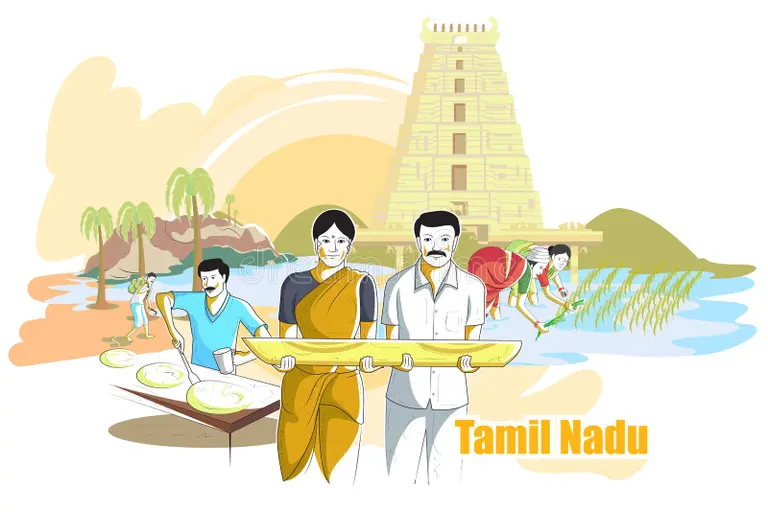An Introduction to Tamilian Superstitions and Beliefs
An Introduction to Tamilian Superstitions and Beliefs
An Introduction to Tamilian Superstitions and Beliefs: A Window into a Culture’s Soul
Every culture in the world has a rich and fascinating tapestry of superstitions and traditional beliefs. These are the unwritten rules, the age-old customs, and the collective wisdom (and sometimes, the collective fears) that are passed down from one generation to the next. The world of Tamil superstitions (மூடநம்பிக்கைகள் – mūṭanampikkaikaḷ) and cultural beliefs in Tamil Nadu is a particularly vibrant and deeply ingrained part of the society. These beliefs, which are often rooted in ancient religious practices, astrology, and simple observation of the natural world, provide a fascinating window into the worldview and the values of the Tamil people. This is the heart of Tamil folklore.
For an outsider or for a young person growing up in a modern world, some of these beliefs may seem strange or illogical. However, to dismiss them is to miss an opportunity to understand the cultural DNA of a society. This guide will serve as an introduction to some of the most common and enduring traditional Tamil beliefs. Understanding these customs is a key part of a deeper cultural education.
Beliefs Centered Around “Drishti” (கண் திருஷ்டி – Kaṇ tiruṣṭi) – The Evil Eye
The concept of the “evil eye” is one of the most powerful and pervasive of all cultural beliefs in Tamil Nadu. The belief is that a person’s jealous or admiring glance can carry a negative energy that can cause bad luck, illness, or misfortune to the person it is directed at, especially if they are successful, beautiful, or happy. A huge number of daily rituals and practices are designed to ward off “drishti.”
- The Black Pottu for Babies: You will almost always see a small black dot (பொட்டு – poṭṭu) on the cheek or the forehead of a beautiful baby. The belief is that this small, imperfect black dot will draw the attention of the admirer to it, thus neutralizing the power of their gaze and protecting the child from the evil eye.
- “Drishti Poosanikai” (திருஷ்டி பூசணிக்காய்): You will often see a large ash gourd (a white pumpkin) hanging at the entrance of a newly constructed house or a new shop. A fearsome face is often drawn on it. The belief is that this gourd will absorb all the negative energy from the evil eye of passersby, protecting the new venture.
- Aarti with Camphor and Chilies: A common ritual to remove the evil eye from a person is “drishti sutruthal.” This involves taking a few dried red chilies and some salt, circling them around the person’s head a few times while saying a prayer, and then throwing the items into a fire. The crackling sound the chilies make is believed to be the sound of the evil eye being destroyed.
Omens and Portents: Signs of Good and Bad Luck
Daily life is often interpreted through the lens of omens (சகுனம் – cakunam). Certain events are seen as auspicious (நல்ல சகுனம் – nalla cakunam) or inauspicious (கெட்ட சகுனம் – keṭṭa cakunam), especially when one is about to embark on a journey or a new venture.
- The Sneezing Rule: If someone sneezes just as you are about to leave the house for an important task, it is considered a bad omen. It is common to pause for a few minutes, drink a glass of water, and then proceed.
- The Cat Crossing Your Path: A black cat crossing your path is considered a bad omen in many cultures, and this is true in Tamil Nadu as well. It is seen as a sign to be cautious.
- The “Nalla Pambu” (Good Snake): While snakes are feared, seeing a cobra (நல்ல பாம்பு – nalla pāmpu, literally “good snake”) is often considered a divine and auspicious sign, as the cobra is associated with the deity Lord Shiva.
Beliefs Related to Time and Day
The timing of an action is often considered to be very important.
- “Raahu Kaalam” (ராகு காலம்): This is an inauspicious period of about 90 minutes that occurs every day. The exact timing of Rahu Kalam is different for each day of the week. It is a deeply ingrained cultural practice to avoid starting any new venture, making a major purchase, or embarking on a journey during this specific time period. Newspapers and calendars will always have the day’s Rahu Kalam printed on them.
- Not Cutting Nails or Hair at Night: There is a traditional belief that one should not cut their nails or their hair after sunset. This is likely rooted in a practical concern from a time before electricity, when it would have been difficult to see properly and one could easily get cut.
- Not Giving Money in the Evening: It is a common superstition that one should not give or lend money to someone in the evening, after the lamps have been lit. The belief is that this will cause the goddess of wealth, Lakshmi, to leave the house.
The Cultural Roots of These Beliefs
It is important to understand that these traditional Tamil beliefs are not just random rules. Many of them have logical or historical roots.
- Practical Origins: As mentioned, the rule about not cutting nails at night is a practical one from a pre-industrial era. Similarly, the belief that one should not stand under a tamarind tree at night may be rooted in the fact that the tree releases a higher amount of carbon dioxide at night.
– A Way of Understanding the World: In a world that can often feel chaotic and unpredictable, these beliefs provide a framework for understanding and for exercising a sense of control. They are a way of navigating the uncertainties of life.
– A Connection to a Spiritual Worldview: Many of these beliefs are deeply connected to the Hindu worldview, which sees the world as being filled with subtle energies, both positive and negative. These rituals are a way of interacting with and managing these energies.
Conclusion: A Rich and Living Folklore
The world of Tamil superstitions is a rich and fascinating aspect of the culture. While the younger, more urban generations may follow these customs with a lesser degree of literal belief, they are still a powerful and deeply ingrained part of the cultural fabric. They are a part of the Tamil folklore that is passed down through families. For anyone who wishes to have a deeper and more nuanced understanding of Tamil culture, an awareness and a respectful observation of these cultural beliefs in Tamil Nadu is essential. It is a window into a worldview that is ancient, complex, and still very much alive today.










